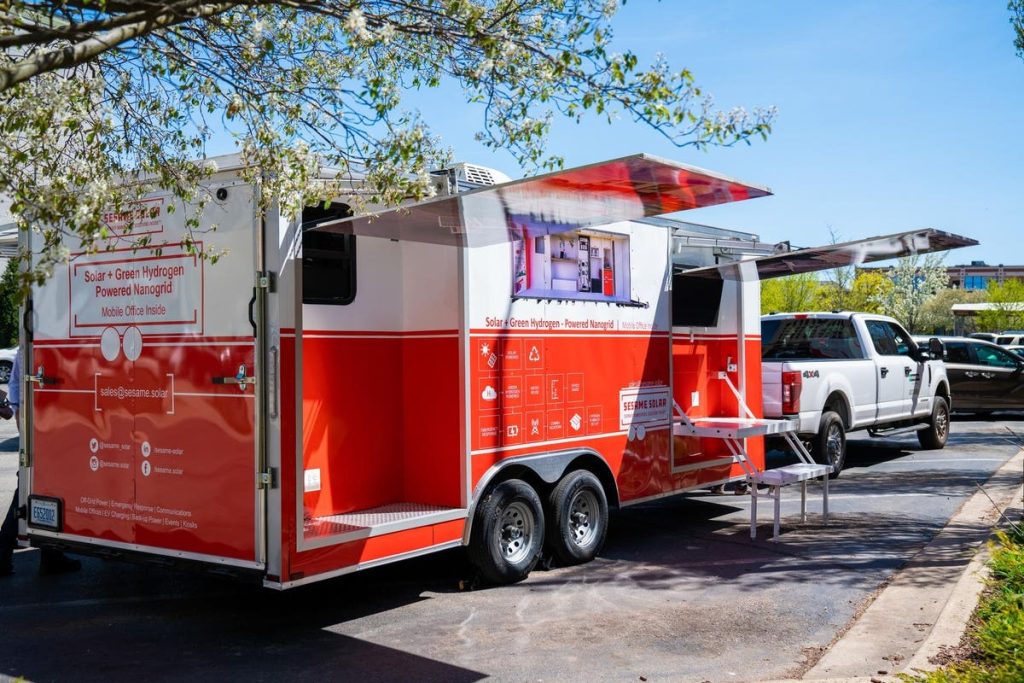Two kinds of technology are coming together to create renewable energy and drinking water for use in everything from emergencies to entertainment.
Sesame Solar out of Jackson, Michigan, makes mobile nanogrids that generate off-grid power within 15 minutes using solar, green hydrogen and battery storage.
The nanogrids consist of a retractable solar array that charges a battery system to produce green hydrogen via electrolyzers. The hydrogen system needs deionized water to run, which Sesame keeps on hand during deployments.
But Sesame has now teamed up with Israel-based Watergen, which makes atmospheric water generators that pull H2O from humidity in the air, purifies it for drinking and has its U.S. headquarters in North Carolina.
By combining their technologies, they’ve come up with a system that ensures a steady supply of deionized water for green hydrogen production, advancing Sesame Solar’s off-grid system, says Lauren Flanagan, Sesame Solar cofounder and CEO.
“Being able to now make our own water as needed, to make our hydrogen gas as needed, to in turn be the backup power to the battery if solar conditions are not ideal, it’s unique. Nobody’s really applied it this way that we’re aware of,” Flanagan says.
Watergen CEO Steve Elbaz said in a statement: “Our collaboration with Sesame Solar is a game-changer which promotes sustainability in mobile and off-grid environments by providing a source of safe, clean water for both drinking and renewable energy production.
“Watergen’s cutting-edge technology, creating water from air within any mobile vehicles, enables for a completely sustainable approach for emergency teams responding to impacted communities.”
Sesame Solar’s mobile nanogrids have been used in recovery efforts during Hurricane Ian in 2022, Ida in 2021 and Maria in 2017, the company says. They’ve also helped out during wildfires in California, and tornadoes and floods across the United States.
Organizations using the nanogrids have included the U.S. Air Force, Comcast and Cox Communications, Santa Barbara County and the Ministry of Public Health for Dominica. Investors include Morgan Stanley, BELLE Capital, PAX Angels and VSC Ventures.
“The whole concept for us is mobile energy independent solutions for a variety of markets,” Flanagan says, allowing for power without typical diesel- or gas-fueled generators.
The Sesame Solar-Watergen system can generate enough power to light up six average homes, as an example, and more than 50 gallons of drinking water per day depending on the situation, she says.
About 55 of the nanogrids, minus the Watergen technology, have been made. “All the new ones will be going out with Watergen solutions integrated,” Flanagan says.
Demonstration units are due to be on the road this month for use in California, Sesame Solar says.
With extreme weather continuing to knock out power in other places like Florida, Flanagan says, “the need for this kind of mobile power is just growing exponentially.”
She was interviewed in late August after Hurricane Idalia hit Florida and wind-driven wildfires killed more than 100 people in Maui.
Sesame Solar had just returned from presenting at the 2023 Operational Energy & Logistics Summit in Honolulu that supports Department of Defense focus areas.
“We’re hoping to get some units in Maui. We’re working on that now,” Flanagan said.
Read the full article here










